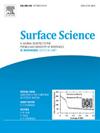co诱导Cu(111)粗化:金属表面反应性纳米团簇的形成和检测
IF 2.1
4区 化学
Q3 CHEMISTRY, PHYSICAL
引用次数: 0
摘要
在反应环境下,金属表面形成纳米团簇是一种具有重要催化意义的现象。这些纳米团簇是由原子从台阶边缘等不协调的位置喷射而成的,它们的存在改变了固体材料的催化性能。我们采用密度泛函理论(DFT)和动力学蒙特卡罗(KMC)模拟来研究铜簇在Cu(111)上的形成和反应性。我们的研究结果表明,与原始Cu(111)和Cu(211)相比,粗糙铜表面上的小铜纳米团簇的反应性要高得多,高达7个原子的大小。对于CO气氛下产生纳米团簇的重组事件,我们确定Cu原子从台阶边缘喷出并从那里迁移到相邻的Cu(111)梯田,在很大程度上是由CO覆盖效应驱动的。通过考虑CO-CO横向相互作用和co诱导的表面重组的KMC模拟,我们表明温度程序解吸(TPD)有望检测高活性纳米团簇。我们的方法展示了在模拟表面反应时如何将表面重组和表面吸附键断裂结合起来,并有助于深入了解反应条件下活性位点的性质。本文章由计算机程序翻译,如有差异,请以英文原文为准。
CO–induced roughening of Cu(111): formation and detection of reactive nanoclusters on metal surfaces
The formation of nanoclusters on metal surfaces in the presence of reactive environments is a phenomenon with important implications for catalysis. These nanoclusters are composed of atoms ejected from undercoordinated sites such as step edges, and their presence alters the catalytic properties of solid materials. We perform density functional theory (DFT) and kinetic Monte Carlo (KMC) simulations to investigate the formation and reactivity of copper clusters on Cu(111). Our results indicate a considerably higher reactivity of small copper nanoclusters, with up to seven atoms in size on roughened copper surfaces than on pristine Cu(111) and Cu(211). Regarding the restructuring events that give rise to nanoclusters under CO atmospheres, we determine that the ejection of Cu atoms from step edges and their migration therefrom to adjacent Cu(111) terraces are, by and large, driven by CO coverage effects. By means of KMC simulations, which account for CO–CO lateral interactions and CO–induced surface restructuring, we show that temperature programmed desorption (TPD) holds promise for the detection of highly reactive nanoclusters. Our approach showcases how surface restructuring and surface–adsorbate bond breaking can be combined when modeling surface reactions and contributes to the development of an advanced understanding of the nature of active site under reaction conditions.
求助全文
通过发布文献求助,成功后即可免费获取论文全文。
去求助
来源期刊

Surface Science
化学-物理:凝聚态物理
CiteScore
3.30
自引率
5.30%
发文量
137
审稿时长
25 days
期刊介绍:
Surface Science is devoted to elucidating the fundamental aspects of chemistry and physics occurring at a wide range of surfaces and interfaces and to disseminating this knowledge fast. The journal welcomes a broad spectrum of topics, including but not limited to:
• model systems (e.g. in Ultra High Vacuum) under well-controlled reactive conditions
• nanoscale science and engineering, including manipulation of matter at the atomic/molecular scale and assembly phenomena
• reactivity of surfaces as related to various applied areas including heterogeneous catalysis, chemistry at electrified interfaces, and semiconductors functionalization
• phenomena at interfaces relevant to energy storage and conversion, and fuels production and utilization
• surface reactivity for environmental protection and pollution remediation
• interactions at surfaces of soft matter, including polymers and biomaterials.
Both experimental and theoretical work, including modeling, is within the scope of the journal. Work published in Surface Science reaches a wide readership, from chemistry and physics to biology and materials science and engineering, providing an excellent forum for cross-fertilization of ideas and broad dissemination of scientific discoveries.
 求助内容:
求助内容: 应助结果提醒方式:
应助结果提醒方式:


